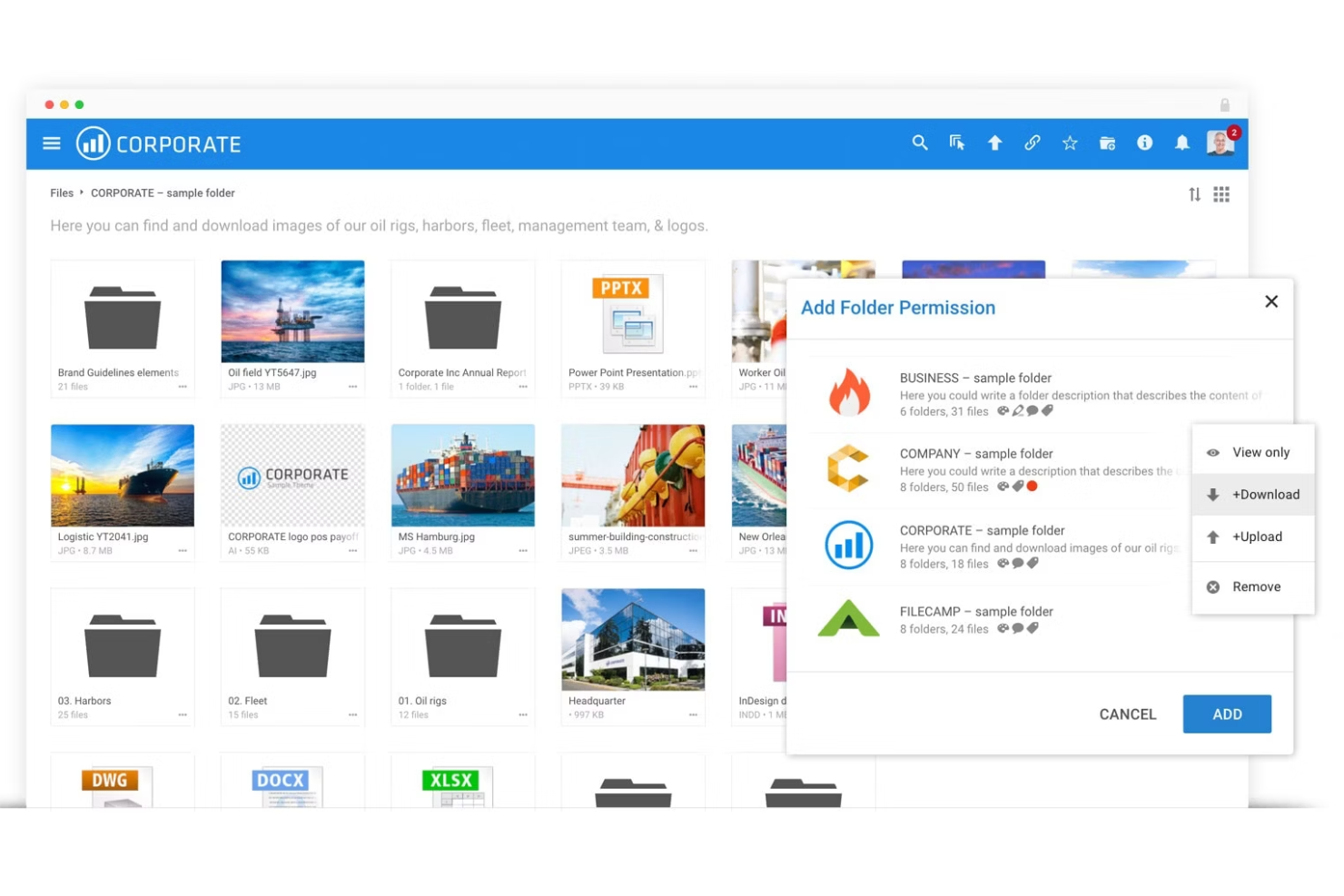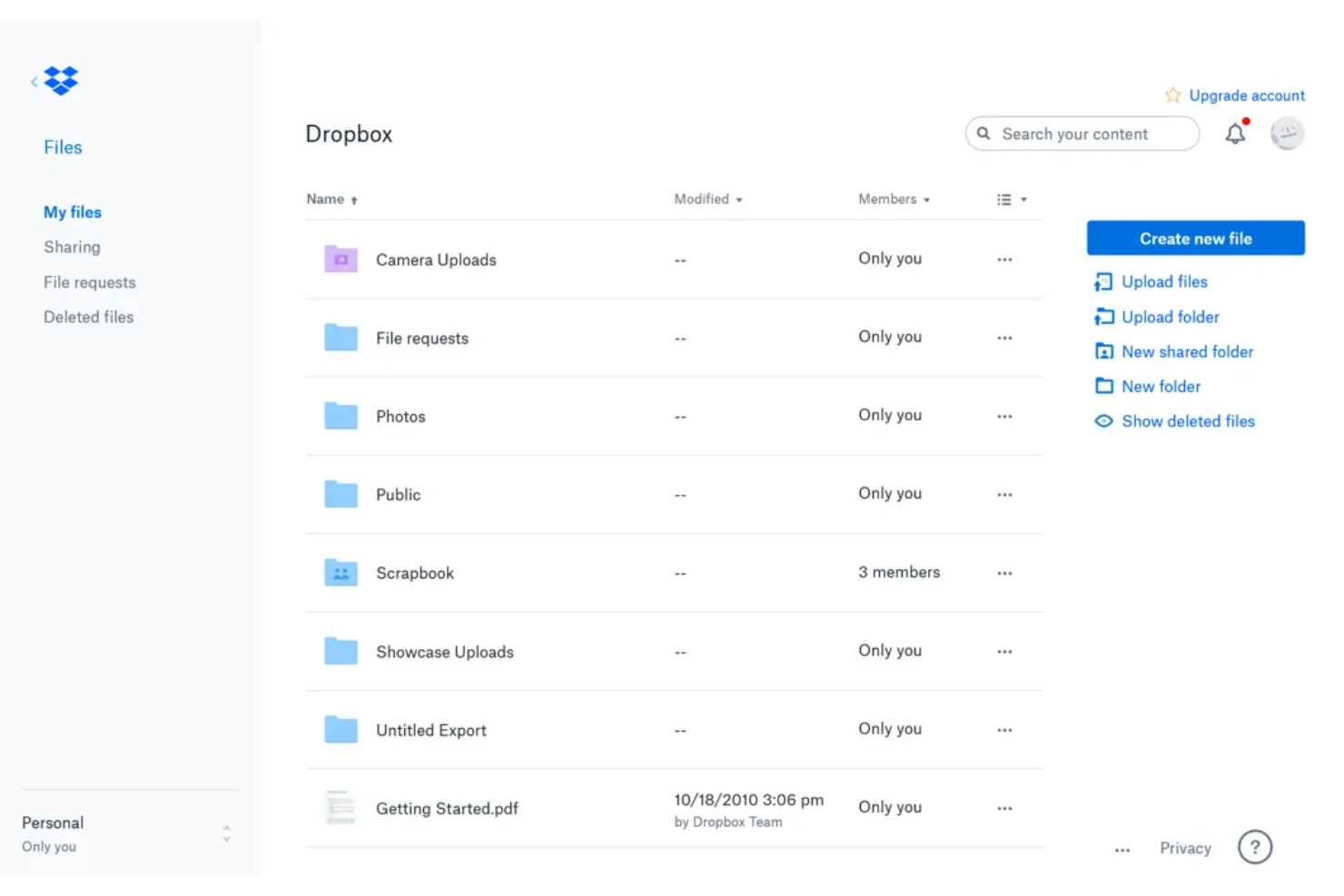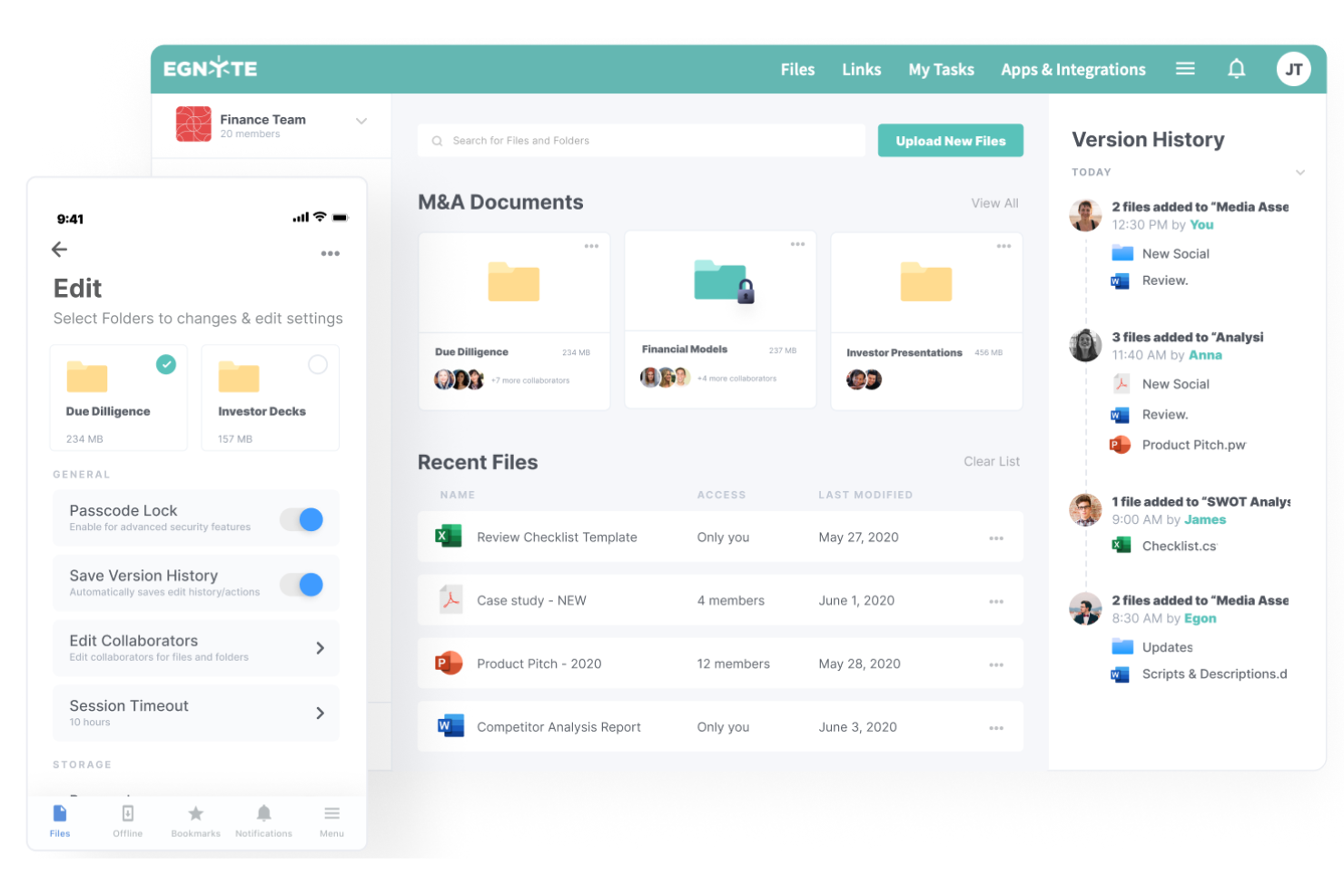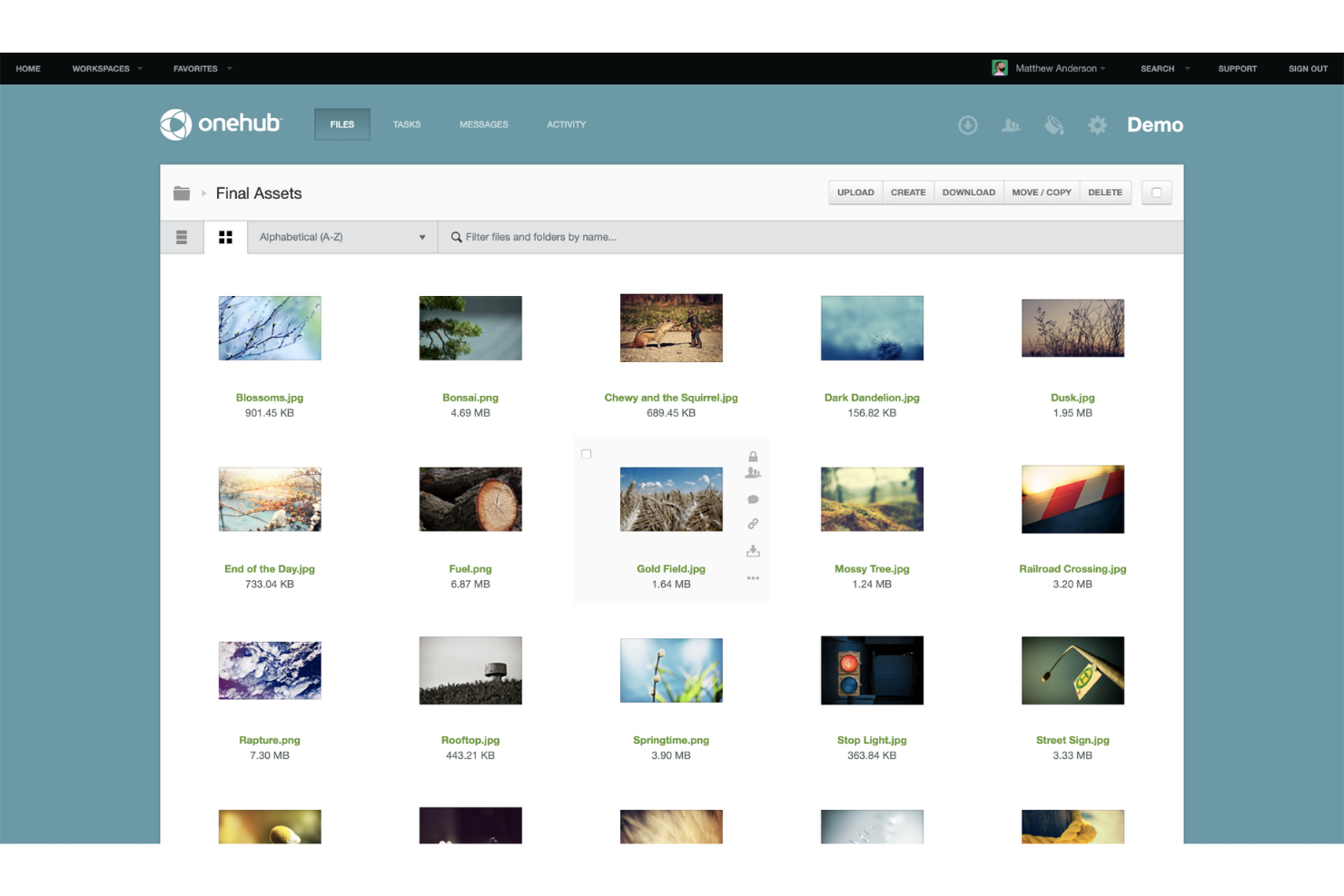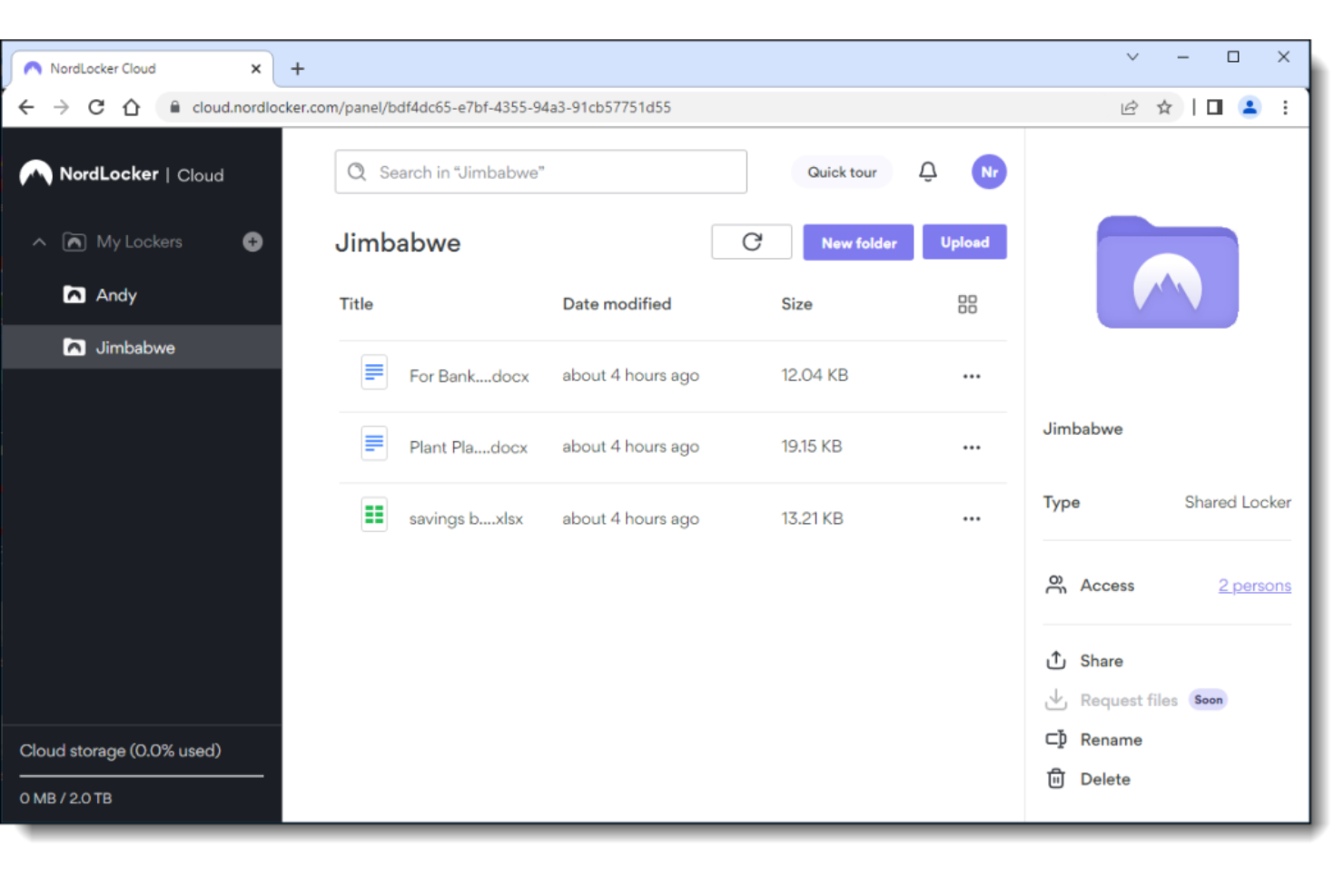10 Best File Sharing Software Shortlist
Here's my pick of the 10 best software from the 19 tools reviewed.
With so many different file sharing software solutions available, figuring out which is right for you is tough. You know you want to transfer and share files with both your team and your clients but need to figure out which tool is best. I've got you! In this post I'll help make your choice easy, sharing my personal experiences using dozens of different file sharing tools with a variety of stakeholders, with my picks of the best file sharing software.
What is file sharing software?
File sharing software is a tool that lets users share and access files over the internet or a network. It supports the transfer of various file types, including documents, images, and videos, between different devices and users. This software often includes features for uploading, downloading, managing access, and ensuring the security of the shared files.
File sharing tools facilitate collaboration, allowing team members to easily work together on documents and projects, regardless of their location. They ensure that files are easily accessible, can be quickly updated, and are securely shared. This software is particularly useful in environments where teamwork and information sharing are essential, enhancing efficiency and reducing the need for physical storage.
Overviews Of The 10 Best File Sharing Software
Read below my list of the best file sharing software and what made me pick them for this list.
Filecamp file sharing software is suitable for people, especially hybrid workers, dealing with media files and who require a branded platform for sharing and organizing assets. Users can access, share, and collaborate on files from any location, and device using Filecamp’s DAM platform.
Why I picked Filecamp: First, I like this platform because it is a powerful file sharing and productivity tool that helps users reduce time spent on tasks such as searching for files, updating file versions, and controlling security and access. This makes it a great technology investment for any business, especially creative ones.
I also like this platform because it offers cutting-edge security features, so you will not worry about file leaks or document security breaches. You’ll securely create folders and upload or download files in any format you prefer, and only people you give access permissions can access the files, making your brand’s digital asset management easy and secure.
Filecamp Standout Features and Integrations
Standout features include online proofing and approval. These two will make your life so much easier as you won’t have to worry about collecting feedback via email or chasing people through multiple channels to get approvals.
Integrations include Mailchimp, Zoho, Salesforce, Adobe Photoshop, and DAM API access. Also, with a paid Zapier subscription, you can also access thousands of other apps based on your integration needs.
Pros and cons
Pros:
- Media library management with easy file sharing and commenting.
- Custom branding with company logo.
- Digital asset management (DAM) API provision.
Cons:
- Many features can be difficult to maneuver.
- Limited third-party integrations compared to other options.
Microsoft OneDrive is a powerful file sharing software for individual use and team file sharing and collaboration. Its intuitive interface and features allow individuals to store files and teams to share files from any device, and anywhere with an internet connection.
Why I picked One Drive: OneDrive is Microsoft’s file storage software that can be cloud-based or on-premise and features auto or manual syncing. But what makes the platform even more outstanding is its services to companies or educational institutions giving them access to more spacious storage capacity than the personal versions, tighter security, and tools for extensive sharing and collaboration from desktop, iOS, and Android devices.
I’ve used OneDrive and its tight integration with Microsoft’s other popular business offerings, like Outlook, Microsoft 365, and Sharepoint server makes it even more attractive.
One Drive Standout Features and Integrations
Standout features include real-time collaboration, deep integration with Microsoft 365, version history, auto or manual syncing, expansive storage (up to 6 GB), and on-premise implementation. In addition, administrators can control user access rights, sharing permissions, and other collaborative features.
Integrations include Microsoft Office, Microsoft 365, Teams, Outlook, Notion, Google Workspace, Google Apps, Lexdocs, and Google Docs. Zapier lets you connect OneDrive with thousands of the most popular apps but requires an additional subscription.
Pros and cons
Pros:
- Sharing controls to authorized users.
- Automatic or manual document backup and version history.
- Advanced security, including encryption, 2FA, and expiration date for shared links.
- Seamless integration with Microsoft apps and easy collaboration within Microsoft Teams.
Cons:
- Limited storage for lower-tier plans.
- May require Microsoft and Microsoft Office ecosystem commitment.
Google Drive is a popular file sharing software ideal for individuals and businesses who rely on G Suite tools and need seamless collaboration within the Google ecosystem. The platform gives 15 GB of free storage, and allows storing any type of file and accessing files anytime, anywhere from your desktop or mobile devices, with control of how files are shared.
Why I picked Google Drive: Google Drive is probably the most popular virtual storage software partly because it comes as a package bundled with Gmail and other Google apps. I’ve included it in this list because of its ease of use, access, and navigation. As long as you have a Gmail account, you'll have all your files stored, categorized, and fully shareable at all times, and from all devices.
I like the platform because it's fully integrated with Google and Microsoft Suite products that eliminate clumsy downloads by providing instant sharing links. You can view the files as a viewer, editor, or commenter — providing real-time document sharing, and collaboration.
GoogleDrive Standout Features and Integrations
Standout features include real-time collaboration and integration with Google Workspace apps. Each document or file uploaded to this platform will have a dedicated chat space for it. There, you can have conversations with the team if you don’t want to use the commenting feature within the editor.
Integrations include Google Workspace apps, Slack, DocuSign, iCloud, Dropbox, Microsoft Office, Zoom, Slack, Facebook, Notion, Workplace, Asana, ClickUp, and webhooks access. It also provides API access. You can also access additional apps using a paid subscription with Zapier.
Pros and cons
Pros:
- Document revisions are automatically saved and can revert back.
- Expansively generous free storage.
- Efficient real-time collaboration.
- Deep integration with G Suite apps.
Cons:
- Large files make Google Docs sluggish.
- Limited offline access makes it only better when online.
Dropbox is a robust file sharing software Trusted by 700+ million users. It is an all-inclusive file sharing software known for its user-friendly interface and smooth synchronization between multiple devices and platforms (desktop, phone, tablet, Windows, Android and iOS).
Why I picked Dropbox: Dropbox file-sharing software is designed to help teams simplify the process of creating, organizing, sharing and collaborating on documents across multiple devices. It is particularly best for teams and students who need to quickly share, access and collaborate on documents and tasks in real time.
This tool stands out for its seamless collaboration and file syncing capabilities across multiple devices and platforms. It backs up and encrypts the user’s cloud-hosted data. But what makes it truly impressive is how it monitors storage access and real-time running tasks to detect unauthorized access making it ideal for hybrid workers, students, and teams who need to collaborate and access files from various devices.
Dropbox Standout Features and Integrations
Standout features include ease of backing up data, and real-time access monitoring making this platform stand out as an ideal file sharing tool.
Integrations are available with popular collaboration, CRM, productivity and communication tools, including Zoom, Slack, Trello, Microsoft Office, Google Workspace, Asana, Canvas, Hubspot, Autodesk, AWS, and Adobe Creative Cloud. It also has an integration with Zapier that you can use to access thousands of additional apps through a paid subscription.
Pros and cons
Pros:
- Efficient third-party app integrations.
- Real-time access monitoring to detect unauthorized access.
- Widespread compatibility and sync with various devices and file formats.
Cons:
- Advanced features come with higher pricing.
- Storage limitations in lower-tier plans.
Tresorit file sharing software stands out for its focus on zero-knowledge encryption, making it suitable for individuals and businesses that prioritize strong security. The platform stores, backs up, and syncs your files using the model of Swiss financial institutions’ security giving users total file security.
Why I picked Tresorit: I used many file-sharing solutions and most lack end-to-end encryption – making files vulnerable to deletion and cyber attacks. But I like Tresorit because it completely encrypts all your files, always, giving you total privacy, access control, and compliance no matter who or where your teams share files with. Its zero-knowledge privacy means other than your team, no other entity, including Tresorit, can see your data.
I also like the platform's storage provision apart from the security. Each user gets 1 TB of storage. If you have more than 10 team members, the cost per user per month is a reasonable investment to use the Tresorit platform.
Tresorit Standout Features and Integrations
Standout features include the e-sign module and revoke email capacity. The electronic signature feature allows you to confidently share sensitive information and gather signatures from multiple recipients. And speaking of recipients, the revoking feature lets you remove access to a file in case an email is sent to the wrong recipients.
Integrations include Outlook, Slack, Gmail, Microsoft Teams, SIEM integration, Active Directory, Admin center API, and Single Sign-On. You can also access thousands of additional apps through a paid subscription with Zapier.
Pros and cons
Pros:
- Local and remote wipe.
- Simple electronic signatures and reduced turnaround times.
- Email encryption system for information security.
- End-to-end encryption and Zero-knowledge encryption.
Cons:
- Might lack some advanced collaboration features.
- Higher pricing compared to some alternatives.
Filestage is a file sharing software designed for hybrid teams that require a structured document and file review and approval process, making feedback fast, focused, and easy to track. It allows you to upload any file type – including documents, images, videos, and audio files and share a link with stakeholders.
Why I picked Filestage: Filestage simplifies file sharing, feedback management, and document approval process for teams. Apart from allowing you to upload any file type and share the link, all invited reviewers on the platform can view, comment and/or approve the file without the need to log in.
I feel Filestage stands out even more because the platform lets organizations or teams invite multiple reviewers, establish custom workflows, and track file versions to streamline the file feedback/approval processes.
Filestage Standout Features and Integrations
Standout features include visual feedback, multiple file reviewers, automatic file versioning, annotation tools, an integrated to-do list, and customizable approval workflows. All of these features help smoothen team collaboration by providing a central hub for communication around feedback and file approvals.
Integrations include Google Drive, Dropbox, Adobe Premier, Notion, Miro, OneDrive, Asana, Adobe After Effects, Figma, Slack, Teams, and Jotform. Additionally, you can access thousands of other apps through Zapier. The platform also provides API Documentation with a RESTful interface, Single Sign On, and SLA.
Pros and cons
Pros:
- Automatic file versioning eliminates email clutter.
- Seamless and organized file review process.
- Simplifies document sharing and feedback collection.
Cons:
- Might not cover broader file sharing needs.
- Primarily focused on review workflows.
Egnyte file sharing platform is suitable for hybrid workers who need a hybrid cloud solution with a balance between on-premises and cloud storage. Egnyte will help you control your critical content, giving you an edge in document management and accessing your files from any device.
Why I picked Egnyte: Egnyte defines and delivers on its promise of making it simple and easy for IT to manage and control content risks such as accidental data deletion, data exfiltration, and privacy compliance. The platform does this while giving business users a faster and smarter way to share and collaborate on files from any cloud, any device, anywhere including external users.
I like Egnyte because the platform combines file sharing with content management and packs advanced features users can deploy on-premise or via the cloud for efficient file sharing and control. This platform is an excellent choice for protecting files and enhancing business agility.
EgnyteStandout Features and Integrations
Standout features include enterprise file sharing, automated and continuous backup, access controls and permissions, syncing, secure external file sharing, and synchronization between the cloud and on-premise. These features ensure that you are always looking at the latest version of each file and that only the people you have chosen to look at certain files are the ones who see them.
Integrations include Microsoft Office, Microsoft 365, Azure, Google Workspace, Salesforce, Practifi, AutoDesk, Raken, AWS, Teams, DocuSign, Science Exchange, and Procore. It also provides Developer API access for custom integrations and the option to connect to thousands of apps through Zapier.
Pros and cons
Pros:
- Hybrid storage options.
- Enterprise File Sharing capabilities.
- Modern user interface and content architecture.
- Controlled and secure external file sharing and content governance controls.
Cons:
- Feature-richness can be overwhelming for simpler needs.
- Pricing might be high for smaller businesses.
Onehub is a cloud-based virtual data room and collaboration tool that helps users securely store and share files with the ability to customize them to meet specific requirements. The platform is suitable for hybrid workers who require a platform for secure data room management, document sharing, and collaboration.
Why I picked Onehub: I picked Onehub because it combines efficient file collaboration and ultra-secure cloud storage (virtual rooms) into an easy-to-use file sharing platform. I also like the platform's ability to provide customizable client portals, great watermarking, stealth collaboration, role and permission control, and full audit trails for document access.
I liked the way you can configure roles by simply assigning each user roles such as administrator, downloader, collaborator, or viewer, which reduces the chances of compromising data.
Onehub Standout Features and Integrations
Standout features include custom branding, granular permissions, virtual data rooms for secure sharing, 2FA, Direct Google Drive integration, powerful document search and unlimited storage. I also liked the fact that client portals can be fully white-labeled, allowing you to customize the portal with your business logo and other design elements.
Integrations include Microsoft Office, Google Drive, Dropbox, Box, DocuSign, Microsoft 365, and Shift. Additional integrations are available through a paid subscription with Zapier.
Pros and cons
Pros:
- Powerful search through instant indexing.
- Comprehensive permission controls.
- Virtual data rooms for efficient and secure file sharing and management.
- Custom branding allows you to own your brand on the platform.
Cons:
- Steep learning curve for new users.
- User interface might not be as intuitive as other platforms.
NordLocker is file sharing software suitable for hybrid workers who prioritize data security and encryption in their file sharing activities. Described as the next‑generation file security on the web, NordLocker allows you to encrypt personal and business data before you share to keep them safe on the device and on the go.
Why I picked NordLocker: NordLocker stands out to me due to its strong focus on file or data security and encryption. With client-side encryption and a zero-knowledge architecture, the platform ensures maximum data privacy for sharing of sensitive files, making it an attractive choice for individuals and businesses that prioritize top-notch security in their file sharing activities.
For me, this tool also provides new technology for data protection in an online space full of cyber criminals, surveillance, and malware, which is very important in today’s society.
NordLocker Standout Features and Integrations
Standout features include features focused on security and encryption such as client-side encryption, zero-knowledge architecture, and cross-platform support. These ensure you can upload, share and review files with assured security and keep your files safe on the cloud, and web.
Integrations include limited but available integrations with NordVPN, Microsoft OneDrive, Dropbox, Apple iCloud, Zendesk, Iterable, Twilio, Google Analytics, AppsFlyer, Bugsnag, and Tune.
Pros and cons
Pros:
- 3GB free cloud storage.
- Impressive drag-and-drop interface.
- Strong focus on security and end-to-end encryption.
Cons:
- Might be an overkill for users not focused on encryption
- Limited integrations compared to other options.
Jumpshare is a great file sharing software for hybrid workers who need to communicate and collaborate visually through annotated files and screenshots through instantly shareable links. It’s an ideal tool for creatives who seek to share their files, screenshots, screen recordings, and collaborate with teams, and clients.
Why I picked Jumpshare: For me, Jumpshare has a clear focus on visual communication and collaboration with instantly shareable links. Its features for annotated screenshots, screen recording, and visual collaboration make it an excellent choice for teams that require clear and concise communication through visuals and have the option of sharing them through links for collaboration.
I also like how the platform's emphasis on these visual tools enhances efficiency and engagement, particularly for hybrid workers seeking effective ways to convey ideas. My overall experience with this platform is positive because while other tools that cost more offer similar features, none offer them all, let alone as quickly and intuitively as Jumpshare.
Jumpshare Standout Features and Integrations
Standout features include an emphasis on visual communication and annotated screenshots. But what makes the platform more outstanding is its ease of use, minimalist design, fast upload and download, and the lack of need for an account to download, allowing you to work, and share seamlessly.
Integrations include Canva, Asana, Slack, Trello, Asana, DocuSign, WeTransfer, Skitch, Dropbox, Gyazo, Zight, Lightshot, Droplr, and Loom. Also offers integration API. With a paid Zapier subscription, you can access thousands of other applications you may need to integrate into your business.
Pros and cons
Pros:
- Rapidly create a screencast and deliver via a custom domain to a coworker.
- Provides a keen minimal design to support ease of use.
- Provides efficient ease of use.
- Emphasis on visual communication, and annotated screenshots.
Cons:
- Provides limited storage and integration.
- Might not cover advanced document collaboration needs.
The 10 Best File Sharing Software Comparison Chart
Here is a table you can use to compare the tools we just covered in the overviews.
| Tools | Price | |
|---|---|---|
| Filecamp | From $29/ month | Website |
| OneDrive | Starts at $6 per user/month | Website |
| Google Drive | Starts at $7.20 per user/month | Website |
| Dropbox | Starts from $9.99/user/month | Website |
| Tresorit | From $18 /user/month | Website |
| Filestage | From $24/user/month | Website |
| Egnyte | From $20 /user/month | Website |
| OneHub | From $20/user/month | Website |
| NordLocker | pricing starts from $3.99/user/month, billed annually | Website |
| Jumpshare | From $8.25 /member/month. | Website |

Compare Software Specs Side by Side
Use our comparison chart to review and evaluate software specs side-by-side.
Compare SoftwareOther File Sharing Software Options
Here are other file sharing software that did not make the top list but are worth your consideration.
- ShareFile
Best for secure enterprise file sharing
- WeTransfer
Best for simple, fast large file sharing via email
- Air
Best for sharing files among creative teams
- Pics.io
Best for organizing digital content
- Wrike
Best for medium to enterprise-level organizations.
- ClickUp
Best for flexible and customizable project and tasks management.
- monday.com
Best for visual workflow management with file sharing needs.
- MEGA
Best for generous cloud storage and encryption for individuals and businesses.
- MediaFire
Best for simple and fast, straightforward file sharing for small businesses.
Selection Criteria For File Sharing Software
Here’s a short summary of the main selection and evaluation criteria I used to develop my list of the best file sharing software for this article:
Core Functionality
I started this review by looking into various file sharing software options, especially the ones that received positive feedback from reviewers and users with a keen eye on core functionalities. Here are the basic functionalities the file sharing software should provide in order to make it onto my list:
- Data Security. Provide security, such as permissions, end-to-end encryption, and user authentication to protect confidential files and documents
- Storage space. Have a good storage capacity to ensure all your files are stored safely in one place.
- Data backup. Backup and recovery — manual or automatic backups — at regular intervals with recovery to reverse corruption or accidental deletion. It should also provide file version history.
Key Features
From my file sharing trials and use, I noted that for a product to deliver the core functionality I outlined above, it needed some key features:
- Type of file-sharing / transmission. The transfer of data over a digital channel can either be a point-to-point or a point-to-multipoint transfer. It determines the speed of data transfer.
- File storage compliance. If you are in a medical field or other industry where file storage is regulated, you might need a solution that is HIPAA or GDPR-compliant, among many other certifications.
- File size limit. Some file sharing solutions have limits on the size of sharable files. If you need to share large files go for a solution that allows sharing of large data files. This is also determined by the space they offer.
- Supported file formats. A quality file sharing software should support various file formats, such as document, audio, video, picture, and links, depending on what you or your organization uses.
- Security level. Some file sharing platforms offer basic security, others offer enterprise security levels. The best file sharing software should offer various levels of security such as access and device permission, end-to-end encryption, expiry dates for links, access alerts and user authentication (two-factor authentication and MFA).
- File version control. This is for sharing software where the files are not temporary, such as Sharepoint from Microsoft’s Office 365 suite. File versions should be kept so the team can refer to them if needed.
Usability
In this review, I prioritized file sharing software that created a positive user experience and showed ease of implementation and use.
You want a file sharing software that is usable, with a learning curve that’s not too steep. By usable I mean the interface is not difficult to navigate and make your way around. The usability of file sharing software — based on my review — should also include features such as a clean interface, neatly organized menus, easy to deploy and manage, document tracking, real-time collaboration and reporting to allow users to collaborate, and easily share their files.
Software Integrations
I selected solutions that integrate easily with other tool providers and platforms to save your search time, I've noted key integrations for each system.
These integrations allow the software to expand its capabilities and include pre-built integrations that you can use right away, custom integrations that you have to build using an API, and third-party integration platforms such as Workato and Zapier.
Pricing
You should also look at the file sharing platforms pricing vis-a-vis your budget. Many file sharing software offer plans such as individual, team, business and enterprise with charges based on a monthly cost per user. Some of these tools also offer a free plan for basic file sharing.
I examined the file sharing software’s pricing details to see their plans and find out if there are any demo options and free trials.
Supplier reputation
I selected the file sharing platforms that have some of the best reviews from users. You need to choose a software application that not only has the best features but also has the best vendor reputation. The only best way to know that is to find out what the reviews say and not what the vendor says. Most positive feedback shows a great vendor reputation.
File Sharing Software FAQs
Find answers to common questions other people ask about this topic.
What is file sharing?
File sharing is the act of transferring digital files between devices or users, via the Internet, for collaboration or distribution purposes. For example, sending a presentation to a colleague through email or sharing project files using a cloud storage service like Dropbox, Filestage, or Google Drive.
What is the main benefit of cloud-based file sharing?
The primary benefit of cloud-based file sharing is the ability to access and collaborate on files from anywhere with an internet connection, enabling seamless collaboration among distributed teams and eliminating the need for physical storage devices.
How secure is file sharing?
The security of file sharing depends on the type of file sharing software, methods, and tools used. While reputable cloud-based platforms often employ encryption and security measures to protect data, it’s important to choose trusted services, implement strong access controls, and user services that follow best practices to enhance security.
What’s Next?
File sharing software and platforms are transforming how people collaborate on projects. It has mostly impacted teams and hybrid work environments but even in onsite businesses, files are constantly changing hands, making these tools important for every work and learning setting.
But speaking of documents you may want to create and share, we have two great guides on how to create a project plan in ten easy steps and a project communication plan (that comes with a template). Those files go out to stakeholders so I’m sure you’ll want to get them right the first time around.
Related tool lists:
I hope my detailed file transfer software guide and breakdown have helped you find the right fit or given you an idea of how to find one!
If you wish to learn more about file sharing software and other productivity tools, solutions, subscribe to our newsletter.





